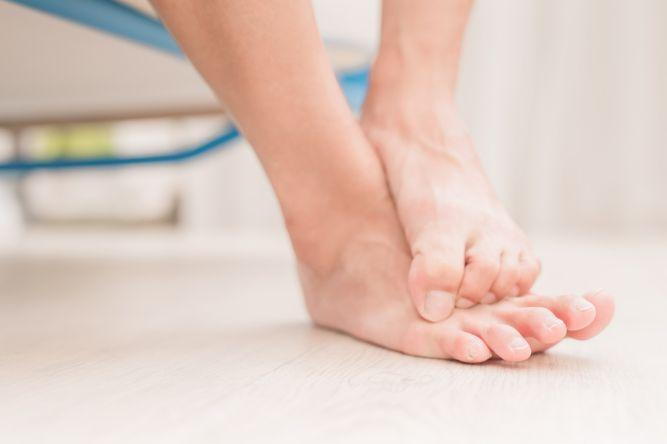COVID Toe: How Coronavirus Can Affect Your Feet
posted: Jul. 19, 2022.

Since the COVID-19 pandemic began, the media has reported some fairly unusual symptoms associated with the disease. Most people have dealt with common colds and loss of smell/taste, while others have experienced digestive issues and eye problems. Perhaps the strangest cases to come out of the coronavirus infection are COVID toes.
According to a small study published in the British Journal of Dermatology, research shows that participants of the study, all of which had tested positive for COVID-19, were found to have chilblain-like lesions, redness, and swelling on their hands, feet, and toes.
Researchers found that the symptoms developed as a result of an immune response containing high levels of a specific antibody called type I interferon. Interferon is known as a protein involved in the process of inflammation.
COVID Toe Symptoms
The study suggests that COVID toes closely resemble the symptoms of chilblains. Chilblains are red patches of skin with itchy sores on your feet and hands due to exposure to cold, damp environments. Most people experience chilblains during the autumn and winter seasons, and it’s more common than COVID toes.
If you’re experiencing chilblain-like lesions and haven’t been exposed to cold temperatures, COVID toe may be the culprit.
The common symptoms associated with COVID toes include the following:
Inflammation
Skin discolouration: One or more toes may look red, purple, or bruised.
Itchy rash
Burning sensations
Rough skin
Painful raised bumps
A lace-like pattern on the skin
Blisters
Pain, soreness, or tenderness
While COVID toe may affect one or more of your toes, it can affect your fingers or hands, and symptoms can last up to 10 to 14 days or for months.
Why Are People Getting COVID Toes?
The verdict on why only some individuals with the COVID-19 virus are experiencing COVID toe is still up in the air. However, the main consensus is that it has to do with the response from your immune system. Every individual’s immune response reacts differently to the virus.
Another theory is that COVID toes develop as a response to the lifestyle changes brought on by the lockdown. This can include walking barefoot in homes without heated floors, inactivity, and increased time spent in sedentary positions. While this theory is unproven, it’s an important reminder to take care of your feet even when you aren’t standing on them all day.
When Did Doctors First Notice COVID Toe?
The discovery of COVID toes may have been detected as early as March 2020. A case study confirms detailed information pertaining to a 13-year-old boy who found lesions on both feet before noticing the usual COVID symptoms. Podiatrists in Spain had begun to register numerous cases of patients with similar symptoms, such as purple-coloured lesions that looked similar to chickenpox, measles, and chilblains.
Who is Most Affected?
While COVID toes can develop in people of all ages, young patients like children, teens, and young adults are more likely to be affected by it. Children and young adults are known to have stronger immune systems and have a stronger local response. Many of the young people affected by this skin condition are deemed healthy, and many may never develop other common symptoms from the virus.
Is COVID Toe Contagious?
Doctors aren’t sure whether COVID Toe is a contagious condition. They also don’t know whether a person is still contagious when they develop COVID toes. However, we all know that the COVID-19 virus is contagious and that we should follow the same precautions to ensure it isn’t spread.
What to Do if I Have COVID Toe?
If you develop COVID toes and don’t have any other symptoms of the virus, you shouldn’t assume you have COVID-19. Lesions and chilblain symptoms can be seen in other conditions. Your best bet is to get tested for the virus and take it from there.
However, you can expect your rash to last anywhere from two weeks to months. Doctors recommend keeping your feet and toes warm and dry and waiting for the symptoms to go away. Some patients have experienced debilitating pain, such as a 13-year-old girl in Scotland. If you’re experiencing severe symptoms that are too painful to manage, contact a doctor for further treatment.
How is COVID Toe Treated?
If you develop swelling or lesions on your toes or fingers, you should contact your primary care physician or a dermatologist. A dermatologist can determine whether it’s COVID toe or a separate condition, such as chilblains.
While treatment for COVID toe is still under debate, some researchers recommend no treatment at all. In some cases, the condition goes away on its own. However, doctors have argued that some treatments may ease the symptoms associated with the virus.
Some possible treatments may include:
Antibiotics
Paracetamol
Antihistamines
Topical steroids
To reduce pain or itching, apply hydrocortisone cream to the affected areas.
When dealing with lesions or swollen feet, it’s best to avoid restrictive clothing, such as socks or ill-fitting shoes.
We Can Help
While COVID toe may go away on its own, you may experience pain and discomfort for long periods even after getting over the sickness. That discomfort can harm your body, especially your feet. Our team of skilled chiropodists strives to ensure all patients are given the services they need. We can assist in diagnosing the issue and suggest multiple treatment options to alleviate the pain. Contact our foot clinic in Toronto to learn more about what we can do for you.